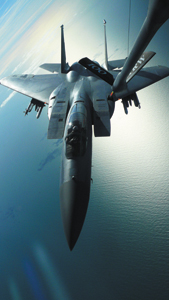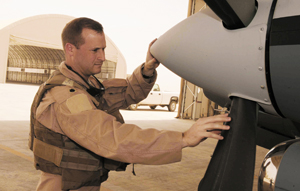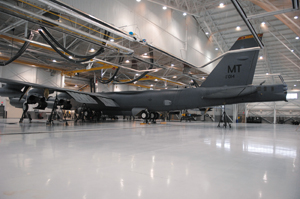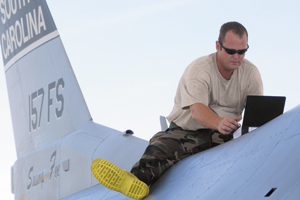The Air Force is in the grip of a major force-shaping campaign. Changes generated by the initiative will ripple across the entire service, but they will be felt most acutely by the airmen in the combat air forces.
Fighter—active, Guard, and Reserve—units will see the accelerated retirement of roughly 250 fighters in line with a detailed plan announced by Air Force leaders in May. The ramifications of this initiative on USAF’s personnel are just now coming into focus.
 |
An F-15 from RAF Lakenheath, Britain, takes on fuel. |
USAF is retiring legacy fighters to achieve a smaller and more sustainable fighter force and to redistribute its people for higher priority missions. The greatest effect might be on people, as airmen at 21 bases will see assignments and career fields change, families move sooner than planned, and communities weigh the economic consequence of pilots, aircrews, and maintainers leaving or arriving.
Every career field at the bases involved “will be affected in some way,” said Lt. Col. David T. DuHadway, chief of rated force policy on the Air Staff.
The combat air forces restructuring plan was announced days after President Obama released his defense budget request for Fiscal 2010. A total of 249 fighters—112 F-15s, 134 F-16s, three A-10s—will be flown to the boneyard at Davis-Monthan AFB, Ariz.
This group will be joined by another five F-16s previously scheduled for retirement next year. The average age of the targeted A-10s and F-15s is 30 years. The average of the F-16s is 24 years.
Secretary of the Air Force Michael B. Donley said that USAF seeks to exploit a “window of opportunity”—a brief period of a few years in which it can, with little short-term risk, jettison some older fighters and use the savings to upgrade remaining Generation 4 fighters to higher capability. That would have to take place before the rise of other military powers slams that window shut.
Working with the service’s new F-22 Raptors, the fourth generation CAF will have a “more flexible and lethal bridge to fifth generation fighters like the F-35,” Donley argued.
Estimated savings, $355 million in Fiscal 2010 and $3.5 billion over the next five years, would be used to modernize today’s fighter and bomber forces as well as buy upgraded munitions and more modern missiles. Some of the savings also would be spent on critical intelligence capabilities such as the advanced targeting pod and enabling technologies for tactical air controllers and special operations forces.
In sum, Air Force leaders say they seek to rebalance the components of the CAF. They are seeking resources to bolster the nuclear enterprise (USAF’s current top priority), plus special operations and intelligence-surveillance-reconnaissance assets.
Though the CAF plan is reflected in the Fiscal 2010 budget request, it immediately ran into some resistance from lawmakers representing districts losing aircraft and personnel.
More Questions
“I think this community feels more threatened than at any time in the last 15 to 20 years,” said Rep. F. Allen Boyd Jr. (D-Fla.) in a public forum he hosted with Donley and Air Force Chief of Staff Gen. Norton A. Schwartz at Tyndall AFB, Fla. Plans call for stripping Tyndall of two F-15 squadrons, comprising a total of 48 aircraft.
Boyd is on the House Appropriations Committee and was able to add to the Fiscal 2010 defense appropriations bill, passed by the House, language that could delay the Tyndall aircraft retirements until the Air Force provides a full report on long-term effects.
Boyd also seeks an independent review by a federally funded research and development center of the restructuring plan, and of USAF’s cost-benefit analysis on moving F-15 training to Oregon.
Boyd told the Panama City (Fla.) News Herald that Air Force officials had previously said F-15s at Tyndall were to retire in 2013 and would leave a fighter gap until F-35s arrived.
Air Force officials have made themselves available to lawmakers to explain the CAF plan in detail for impacted areas and have handled many Congressional and private inquiries to date. Still, the plan faces considerable skepticism.
“I’m sure we’re not done answering questions,” said one senior officer.
 |
Lt. Col. Phillip Stewart inspects a new MC-12 ISR aircraft at Joint Base Balad, Iraq. USAF restructuring will shift airmen out of fighter missions and into emerging growth areas. |
Even so, the Air Force plans to support its new, high-priority mission areas with personnel. Some 13,400 active duty slots, which had been written off the books, became available when Defense Secretary Robert M. Gates halted the Air Force’s drawdown and raised end strength to nearly 333,000 active duty personnel.
Roughly another 4,000 personnel will become available with the fighter force rollback.
“Those two actions,” said Col. Bill Snodgrass, chief of the manpower programming division at USAF headquarters, “allowed us to do a complete scrub of missions and corporately vet through the Air Force how we want to utilize those available manpower authorizations.”
To bolster the nuclear enterprise mission, a fourth active duty B-52 Stratofortress squadron stood up at Minot AFB, N.D., Sept. 3. Creating this new bomb squadron will allow one B-52 unit to be focused solely on nuclear weapons delivery at all times.
The service inventory of 76 B-52s will not change, but airplanes in attrition reserve status will become primary mission aircraft and be manned and funded for the new squadron. Minot’s population of aircrew and maintenance teams will rise.
Approximately 1,600 more airmen will be reassigned to unmanned aerial vehicle units. These systems include the MQ-1 Predator, MQ-9 Reaper, and RQ-4 Global Hawk, as well as priority ISR programs like the MC-12 Liberty Project Aircraft. The personnel infusion will help build Air Force capacity to field the equivalent of 50 UAV orbits by 2011 in support of operations in US Central Command’s area of operations.
Another 2,500 personnel will expand distributed common ground systems and information processing, exploitation, and dissemination capabilities to support combatant commanders’ need for actionable ISR.
“The programs rely on well-trained manpower to handle, analyze, and put into context imagery and signals intelligence for the warfighter,” Snodgrass said.
The Air Force Chief of Staff has warned that his service’s advantage over potential adversaries is eroding and that this trend “endangers both air and ground forces alike.” What is needed, Schwartz said, is “a very significant investment in bridge capabilities and fifth generation aircraft.” CAF restructuring “gets us there,” he said.
Faster retirement of fighter aircraft was one of the results from force guidance that Gates issued last fall. The Air Force was to look out five years and find areas of fighting force overmatch against potential enemies.
These years are an “opportunity where we don’t see the threat increasing at such a rate that we can’t afford to divest ourselves of some fighter forces and reprioritize money and manpower savings toward higher-priority missions,” said Col. Jack Forsythe, chief of the combat forces division on the Air Staff.
Almost 260 pilot billets will be affected by CAF restructure, said DuHadway. Follow-on assignments “will be worked individually, based on needs of the Air Force, manning levels at other CAF bases, and the individuals’ desires,” he added.
 |
A B-52 bomber is inspected for cracks at Minot AFB, N.D., where a new B-52 combat squadron was recently established. Strategic nuclear forces will see increases in assigned personnel. |
Person by Person
Though cockpit numbers are declining, DuHadway said, the Air Force knows the investment it has in these pilots.
“We’ll use existing personnel policy to make sure we put them where we need them,” said DuHadway. “We will see many pilots go to staff positions, if their grade and time in service permit. Others will fill other operational pilot billets, to include fighters, trainers, RPVs [remotely piloted vehicles], and air operations center jobs.”
Adding personnel to unmanned aircraft missions, said DuHadway, will continue on pace. This highly publicized effort at Creech AFB, Nev., the hub of UAV training and operations, isn’t being accelerated by the CAF restructuring.
“We’re not going to take the 4,000 people, move them all from fighter bases, and put them all at Creech,” DuHadway noted. “We will continue to draw aircrew to operate and train intel experts and to process, exploit, and disseminate the information from across the service, like we do today.”
The Air Force Personnel Center will continue to work person by person to figure out what missions are a good fit. “If there’s a need in the A-10 community, for example, for an instructor to stay in the A-10, we’ll do that,” DuHudway said. “These fighters are not going away entirely. We may just have to move them through a PCS [permanent change of station].”
The same is true for the maintainers. The personnel center will look at overall personnel manning for specialties involved, both on the maintenance side and office support personnel, in order to figure out best use of the personnel. No bases will close, so the effect on support personnel will be moderate.
“Some may move, because the size of a force support squadron might not need to be as big if a lot of the operators and maintainers do move away,” said DuHadway. “By no means does CAF restructuring mean instantaneous PCS for everybody.”
The Air Force isn’t changing the way it manages the movement of personnel, DuHadway said.
 |
SSgt. Kary Bearden, a crew chief with the 169th Fighter Wing at McEntire JNGB, S.C., checks the status of an Air National Guard F-16. Many units will quickly retire old fighters under the CAF restructure, but McEntire will keep its Vipers until they are replaced by F-35s. |
He explained, “We’re still trying to balance the requirements we have as a service with our inventory of human capital, and making sure that we manage that carefully. It will always depend on how much time individuals have in service, the individual’s desires and expertise, and most importantly the needs of the Air Force.”
Snodgrass noted that the service will be “in-sourcing”—that is, taking back operations run by contractors and converting those positions to government jobs—thus reversing an outsourcing trend which occurred in the era of Secretary of Defense Donald H. Rumsfeld. The Air Force alone has identified 13,800 contractor jobs for conversion to federal civilian positions by Fiscal 2014. About 4,500 of those would be converted in Fiscal 2010.
“Those are pretty significant numbers,” said Snodgrass. Where the conversions will take place, by base, hasn’t been set.
“Until we go through our contract-by-contract review, we just don’t know,” he said. The review might not conclude until the first months of calendar 2010.
| A Calculated Risk
Air Force leaders recognize that their restructuring plan entails loss of some capability relative to potential adversaries. “We feel that we are at about moderate risk” for executing the nation’s two-war strategy, said Col. Jack Forsythe, a combat forces planner on the Air Staff. If the strategy is changed during the current Quadrennial Defense Review, “then we’ll have to go back and look at how we’re postured.” Although potential enemies have advanced missile systems today, Forsythe noted, the Air Force believes the deadliest SAMs won’t be seen until much further into the “outyears.” Potential threats will include better adversary aircraft and air-combat missiles, as well as a great proliferation of advanced “double digit” SAMs. To reverse the erosion of air dominance, Forsythe said, the Air Force must invest in systems to “buy back” that capability. “We absolutely need fifth generation capability to buy back access to the modern battlespace,” he said. This means more fifth generation aircraft. With the F-22 program halted, the F-35 will shoulder a heavy responsibility. |
| The Iron Is Moving
USAF’s combat air forces restructuring cuts across active, Air National Guard, and Air Force Reserve forces. Fighters in active duty squadrons will drop by 199 aircraft or 16 percent. The cut is six percent for the Air National Guard (which will lose 33 aircraft) and the Air Force Reserve, which will lose six. (Another 16 fighters will come from backup-attrition reserve to reach the 249 destined for the boneyard.) Fifty-one aircraft being retired are based overseas (from England, South Korea, and Germany), and 187 are on bases located in 12 states. Among active duty F-15 bases, Tyndall AFB, Fla., will lose 48 aircraft, and Elmendorf AFB, Alaska, will lose 24. From the active duty F-16 bases, Luke AFB, Ariz., will lose 28 aircraft and Hill AFB, Utah, will lose 24. Klamath Falls Arpt., Ore., is—and will remain—a Guard and Reserve F-15 training base but will be receiving aircraft. Tyndall currently is the only active duty training base for F-15s and will lose the mission, becoming an F-22 training base instead. Other areas of the force are also booming. Cannon AFB, N.M., and Hurlburt Field, Fla., are getting more special operations aircraft. “We are adding aircraft, adding aircrew, and we’re growing the support personnel footprint there as well,” said Col. David T. DuHadway, rated-force policy chief at the Pentagon. The remaining legacy fleet, however, will be more potent than ever. “It’s very important to state we are not buying fifth generation aircraft with the money saved,” said Col. Jack Forsythe, combat forces planner. “What we are buying is critical enabling capabilities [for the remaining aircraft, to] help bridge us to a fifth generation force.” This will include radar upgrades, improved air-launched missiles, including the AIM-9X and AIM-120D, and preferred munitions such as the 250-pound Small Diameter Bomb to reduce collateral damage in attacks against enemy targets. A follow-on effort called the Small Diameter Bomb II will give pilots even more capability against moving targets. |